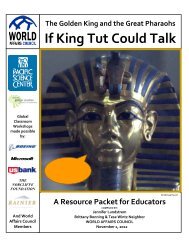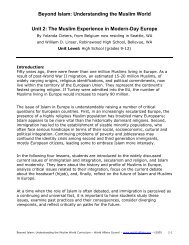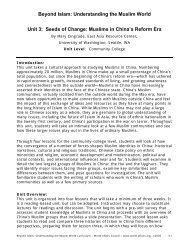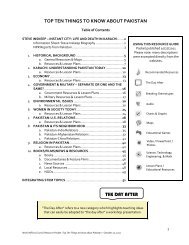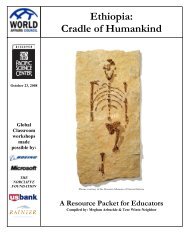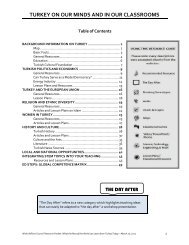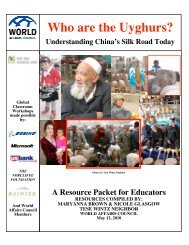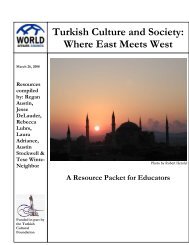The Japanese Approach to Environmental Issues - World Affairs ...
The Japanese Approach to Environmental Issues - World Affairs ...
The Japanese Approach to Environmental Issues - World Affairs ...
You also want an ePaper? Increase the reach of your titles
YUMPU automatically turns print PDFs into web optimized ePapers that Google loves.
SEATTLE JAPANESE LANGUAGE SCHOOLhttp://www.seattlejapaneseschool.org/<strong>The</strong> mission of the Seattle <strong>Japanese</strong> Language School is <strong>to</strong> give instruction in the <strong>Japanese</strong> Language,augmented by the introduction of culture and his<strong>to</strong>ry of Japan, and <strong>to</strong> enhance the learning process.RELIGIONSPICE: JAPANESE RELIGIONShttp://spice.stanford.edu/docs/japanese_religions/<strong>The</strong> <strong>Japanese</strong> religious tradition is made up of several major components, including Shintô (Japan’searliest religion), Buddhism, and Confucianism. Christianity has been only a minor movement inJapan. However, the so-called “new religions” (shinko shukyo) that arose in the nineteenth andtwentieth centuries are a prominent feature of <strong>Japanese</strong> religious life <strong>to</strong>day.ASIA FOR EDUCATORS: CONTEMPORARY JAPAN – CULTURE & SOCIETYhttp://afe.easia.columbia.edu/at_japan_soc/In addition <strong>to</strong> the traditional religions of Shintô and Buddhism, Japan is also home <strong>to</strong> more than sixhundred “new religions” (shinko shukyo), which incorporate Buddhist, Shintô, and Christian elements.In the video segments below, Harvard University professors <strong>The</strong>odore Bes<strong>to</strong>r (anthropology) andHelen Hardacre (<strong>Japanese</strong> society and religion) discuss the impact of religious values and traditionson <strong>Japanese</strong> life.ASIA FOR EDUCATORS: SHINTÔhttp://afe.easia.columbia.edu/japan/japanworkbook/religion/shin<strong>to</strong>.htmShintô was the earliest <strong>Japanese</strong> religion, its obscure beginnings dating back at least <strong>to</strong> a periodknown as the Jômon (8000-300 B.C.E.). Until approximately the sixth century C.E., when the<strong>Japanese</strong> began a period of rapid adoption of Chinese civilization, it existed as an amorphous mix ofnature worship, fertility cults, divination techniques, hero worship, and shamanism.SEATTLE BETSUIN TEMPLEhttp://www.seattlebetsuin.com/default.htm<strong>The</strong> Seattle Buddhist Temple is of the Jodo Shinshu tradition under the mother temple of the NishiHongwanji in Japan and is affiliated with the Buddhist Churches of America (BCA). Please visit theirwebsite for more information on Betsuin temple’s mission, his<strong>to</strong>ry and services. Visi<strong>to</strong>rs arewelcome.TSUBAKI GRAND SHRINE OF AMERICAhttp://www.tsubakishrine.org/home.htmlTsubaki Grand Shrine of America is the traditional Jinja Shintô Shrine located on a pristine twentyfive-acresite near Granite Falls, Washing<strong>to</strong>n, less than one hour from Seattle or Eastside. TsubakiAmerica Shrine is the branch of Ise-no-kuni Ichi-no-Miya, Sarutahiko Daihonguu, Tsubaki O KamiYashiro (Tsubaki Grand Shrine), one of the oldest and most prestigious shrines in Japan with ahis<strong>to</strong>ry of over two thousand years.WIKIPEDIA: BUDDHISMhttp://en.wikipedia.org/wiki/<strong>Japanese</strong>_BuddhismIn modern times, there are four main paths of Buddhism, <strong>to</strong> which all schools of <strong>Japanese</strong> Buddhismbelong: the Amidist (Pure Land) schools, Nichiren Buddhism, and Zen Buddhism. Bring students <strong>to</strong>these local temples <strong>to</strong> learn more about Buddhism in the Puget Sound area.26



